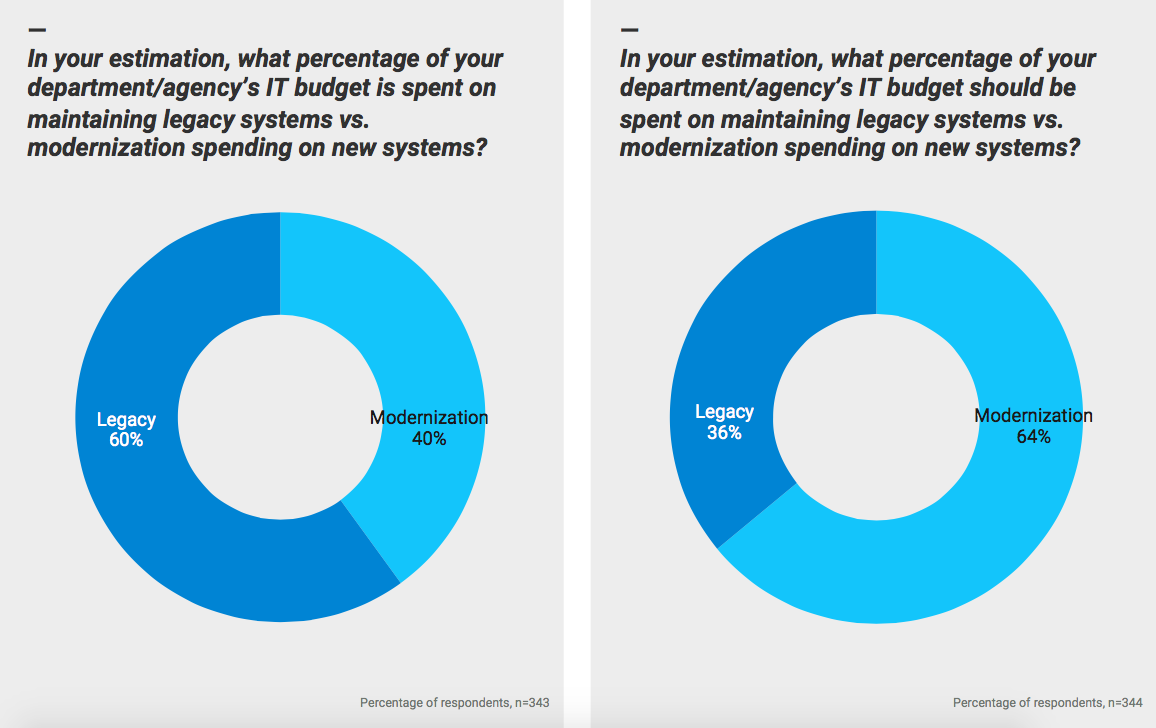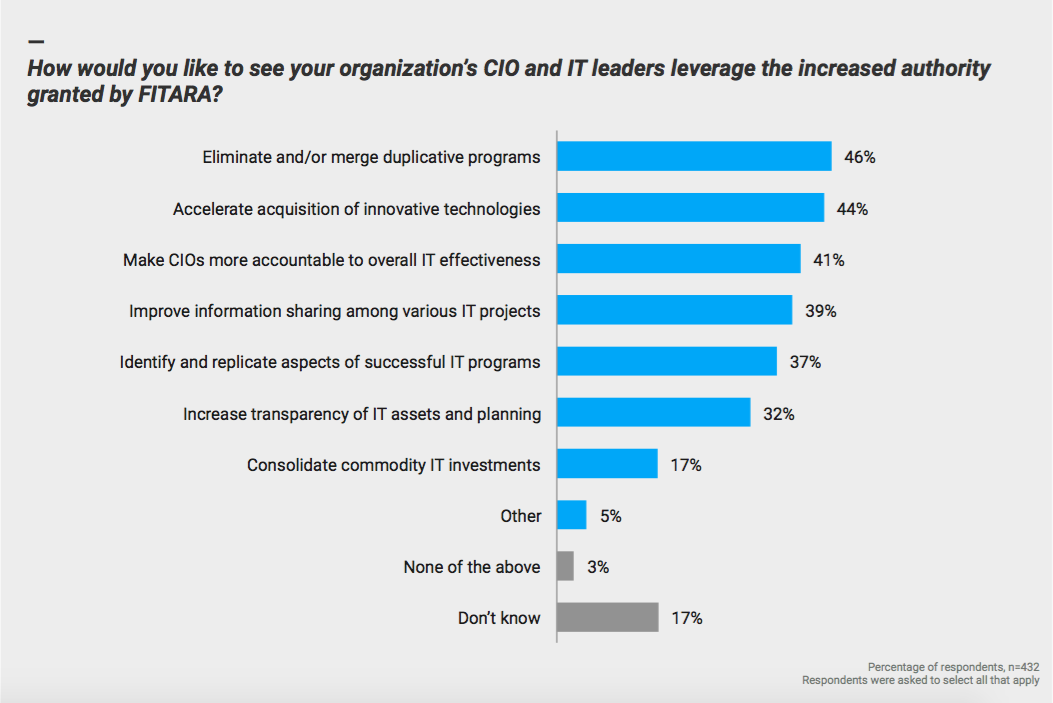
Digital Briefing Center: Federal IT Modernization
Your guide to the top IT modernization issues facing federal leaders
The productivity and efficiency of today’s government workforce hinge on scalable, multi-vendor networks capable of delivering enhanced performance and open-sourced innovation. However, faced with resource constraints and bureaucratic inertia, many agencies are spending primarily on maintaining increasingly outdated and unwieldy legacy systems rather than on modernizing IT infrastructure. Welcome to Government Business Council’s IT Modernization Digital Briefing Center, where we’ll be taking a look at how the federal government can harness new technologies in its quest to advance mission objectives.
Feel free to scroll through the page or use the navigation bar at the top to jump to a specific topic.

Briefing #1
Network Modernization Uncovered
The federal government has innovation on the mind. Emerging solutions such as data analytics, cloud computing, mobility, and the Internet of Things are increasingly defining the way workplaces operate, and agencies are eager to make the transition to streamlined, state-of-the-art IT tools and services. But before any of this can happen, federal networks need some serious revamping – the network infrastructure the government is currently working with hasn’t been updated in at least twenty years, and in order to maximize IT effectiveness, federal networks have to evolve into agile, automated entities capable of sustaining new technologies. In addition to supporting innovation, network modernization also spells massive cost-reduction opportunities – updating networks could save the federal government up to $7 billion over the next five years in networking and maintenance costs.
So what exactly will this new and improved network look like? While legacy networks are characterized by manual configuration, hardware, proprietary standards, and limited responsiveness, the upgraded infrastructure – what many industry leaders are calling the New IP – will be software-centric, virtualized, and highly flexible. Overhauling traditional networks will involve the adoption of several features, including:
- Open standards: An open network lends itself to greater innovation, promotes collaboration between manufacturers and government, and facilitates the development of a user-centric IT environment
- Multi-vendor network architecture: While hiring a single vendor incurs the risk of costliness and stagnation, introducing new vendors into the network encourages competition and product efficiency.
- Virtualization: Virtualizing with software-based technologies such as Software Defined Networking (SDN) and Network Function Virtualization (NFV) expedites the delivery of services and allows for automation and enhanced manageability.
- Ethernet fabrics: Deploying resilient network fabrics paves the way for greater scalability and cost reductions.
Network modernization might require up-front costs, but the alternative – maintaining old, ineffective networks – is becoming increasingly unsustainable. In order to successfully serve citizens, federal agencies need to employ the best of tomorrow’s technologies – and that all hinges on the transition to a powerful, modern network architecture.

Briefing #2
Harnessing the Potential of Open Networks
Let’s go back to something we mentioned in our first post: open standards. Network modernization in many ways hinges on open-source software – software with a source code that can be used, modified, and improved by anyone and for any purpose. While proprietary networks tend to coalesce into vendor lock-in and high costs, an open, multi-vendor network strategy fosters competition and, as a result, higher performance, increased flexibility and security, and continuous innovation among top-quality solutions.
The federal government is becoming increasingly aware of these principles and their potential for unleashing an unprecedented degree of innovation. President Obama’s Open Government Initiative calls for greater public participation and collaboration in government processes – a level of engagement that can only be fully achieved through the adoption of open standards and open source. By directly channeling their values, vision, and expertise into the practice of governance, citizens can help to create a government that is truly “by the people, for the people.” For more information, check out former U.S. Deputy Chief Technology Officer (CTO) Beth Noveck’s TED Talk on what the open government revolution is doing for small and large-scale innovation.

Briefing #3
Boosting Cybersecurity
2015 marked a sea change in the federal government’s perception of cyber threats. Approximately 21.5 million people had their records stolen as a result of the massive OPM data breaches – fingerprints, background investigation findings, login information, and other personally identifiable information. The attack was one of the largest breaches of government data in U.S. history – and in the face of increasingly sophisticated actors, it is unlikely to be the last. At the same time, today’s public sector workforce depends on unbroken, flexible access to data, and with trends toward virtualization, mobility, cloud, and open standards intersecting with constantly evolving threats, agencies need to devise fresh, resilient ways of balancing modernization with resilient cybersecurity practices.
At first glance, this might strike many as being a tall order – innovative technologies are commonly seen as being more susceptible to breaches. However, virtualization and open standards, in addition to bolstering efficiency, can actually help to enhance network security through several key features:
- Isolation and segmentation: Isolating virtual networks mitigates the potential impact of breaches, while segmenting them into smaller networks with separate security domains minimizes access to sensitive information.
- Automation and continuous monitoring: Network virtualization automates and centralizes network management and monitoring, reducing the inefficiencies and potential errors inherent in a physical environment.
- Interoperability: An open network allows for expanded oversight and management; in addition, open standards encourage better designed, more innovative security products and processes.
The public sector faces unprecedented challenges in the realm of cybersecurity, but that doesn’t necessarily spell out stalled progress. By aligning strategies with transformational technologies and network modernization, agencies can strive for greater productivity while continuing to protect critical data and infrastructure. As federal CIO Tony Scott observes, “Cyber threats cannot be eliminated entirely, but they can be managed much more effectively. And we can best do this by aligning and focusing our efforts, by properly funding necessary cyber investments, by building strong partnerships across government and industry, and by drawing on the best ideas and talent from across the country to tackle this quintessential problem of the 21st century.”
Brought to you by

Government networks now face a multitude of users demanding access to massive amounts of data, but they’re losing steam trying to keep up.
The legacy frameworks propelling them forward aren’t getting any more capable, either. But through a revolutionary networking practice called the New IP, limited and wasteful networks can transform into open networks — and they can do it now.
The New IP is a set of principles: open with a purpose, automated by design, programmable, user-centric, systemic and evolutionary. It begins with infrastructure upgrades to fabric-based physical networks and evolves to software-defined, virtual services and advanced methods of control and orchestration. In an end-to-end proposition, the New IP federates network, servers, storage, applications and the edge to deliver the unified and rich experience that federal end users, citizens and warfighters demand.
This new philosophy is emerging at a time when two major efforts are sweeping government IT evolution, Brocade Systems Engineering Director Judson Walker says. The first is a large-scale migration to the cloud; the second is the continuous growth of the Internet of Things (IoT).
Both trends contribute to escalating security concerns. Attack vectors are multiplying exponentially, creating more opportunity for adversaries to do harm. Naturally, Walker says, government must change its approach or risk exposing dated and clunky network defenses to increasingly sophisticated threats. Security strategy must shift to become just as flexible and agile as the tools at the enemy’s disposal.
The New IP can bring about that shift.

Briefing #4
Tackling Federal Modernization
So with all this evidence on the benefits of new networks and technologies, federal agencies must be well on their way toward modernization, right? Wrong. In his 2015 testimony before the Senate Finance Committee, Commissioner of the Internal Revenue Service (IRS) John Koskinen observed that when it comes to IT, the government still has “applications that were running when John F. Kennedy was President.” An October 2015 survey by Government Business Council (GBC) backs Koskinen up – 48 percent of federal employees believe that their agency doesn't spend enough on implementing new technologies. A November 2015 GBC study digs deeper: while federal leaders identify a host of cutting-edge IT solutions and capabilities that could serve to enhance mission effectiveness, they note significant discrepancies between their ideal conception of workplace IT and the reality of agency progress. When asked about their organization’s IT budget, federal leaders estimated their agencies to be spending 24 percent more on sustaining legacy systems than they should be:
Government Business Council, "Inside Federal IT Modernization" (March 2016)
Why this evident reluctance to transition from legacy to modernization spending? Respondents cite resource constraints as an obstacle; however, modernization, while requiring up-front spending, could actually help organizations avoid operational costs in the long run. Thus, the reason behind agencies’ slow progress toward modernization may be less structural than cultural. Jason Bonander, Director of the Office of Informatics and Information Resources Management at the CDC’s National Center for Chronic Disease Prevention and Health Promotion (NCCDPHP), observes a core disconnect in the way that government approaches acquisitions: “Historically, the federal government has always thought about IT in the same way that you would think about buying a car: pay it off, drive it for hundreds of thousands of miles, and perform maintenance on it to keep it running.” According to Bonander, there has to be a fundamental shift in federal procurement strategy – rather than simply maintaining antiquated systems, agencies should be regularly assessing whether technologies satisfy organizational needs and making updates accordingly.

Briefing #5
Federal Tech Leaders
Heads up, Washington – there’s about to be a new sheriff in town. According to U.S. Chief Information Officer (CIO) Tony Scott, the White House is poised to name someone as the nation’s first Chief Information Security Officer (CISO) – a cybersecurity shaman for the rapidly evolving threat environment. The announcement follows a year of unprecedentedly large-scale cyber attacks, including last summer’s revelation of the now-infamous Office of Personnel Management (OPM) breaches. Says Scott, “I think one of the most important things this role can do is pull together all of the people in the federal government and make sure we have a well-thought through and then executed strategy in terms of how all of those entities work together.”
Scott’s vision for the new CISO can just as easily describe the mandate of any other IT-oriented government position. The Obama administration has seen the rise of an emerging layer of federal leaders who, along with agency CIOs, create and oversee both macro and micro IT initiatives. Policy advisers with impeccable tech credentials, this new breed of bureaucrat plays an essential role in furthering federal IT modernization – they have the unique task of detecting hidden opportunities, streamlining spending and procurement, and helping to facilitate the transition to a twenty-first century government. Check out the IT Dashboard to learn more about what organization CIOs are doing in the world of IT modernization investment.

Briefing #6
Moving the Needle with FITARA
Speaking of federal tech leaders, organization CIOs may soon see an expansion of their roles and responsibilities: the federal government is increasingly aware of both its legacy entrenchment problem and the potential of IT leaders to act as agents of modernization.
Enter the Federal Information Technology Acquisition Reform Act (FITARA). Enacted in 2014, FITARA seeks to strengthen the acquisitions process by, among other things, granting federal tech leaders more control and oversight over IT budgets and implementation. The initiative appears to enjoy support across the government: a December 2015 Government Business Council survey shows that a plurality of federal leaders believe that FITARA will improve IT acquisition. However, many of them qualify that CIOs need to prove their mettle with regard to their expanded authority; as one survey respondent notes, “The advantages of FITARA are entirely dependent on the skill, experience, and interest level of the CIO, which seems quite variable.” FITARA-empowered CIOs, federal leaders suggest, would do well to zero in on duplication, innovation, and accountability:
Government Business Council, "FITARA: The Path Forward" (December 2015)
For now, however, FITARA is still in the early stages of implementation: only 2 of 24 major agencies received a “B” grade in the House Oversight and Government Reform Committee’s November 2015 FITARA implementation scorecard; every other agency received a grade of C, D, or F.
Whether or not FITARA will be fully embraced by agencies in the next several months remains to be seen – but federal CIO Tony Scott is confident that it can help propel agencies toward concrete, sustained IT modernization: “80 percent of our spend is on keeping the lights on the stuff we already have. I’m particularly concerned about that 80 percent – we’re on a good path with the 20 percent. I want to focus on how to move the needle on the 80 percent, and FITARA can help us there in a big way.”
About GBC
As Government Executive Media Group's research division, Government Business Council (GBC) is dedicated to advancing the business of government through analysis, insight and analytical independence. An extension of Government Executive's 40 years of exemplary editorial standards and commitment to the highest ethical values, GBC studies influential decision makers from across the federal government to produce intelligence-based research and analysis. www.govexec.com/insights
Report Author: Rina Li
About Brocade
Brocade is partnering with the federal government to modernize networking infrastructure through an innovative approach called the New IP. Built on open standards, Ethernet fabrics, and a software-centric foundation, the New IP empowers agencies to achieve the unlimited possibilities of the cloud, mobility, and Big Data. www.brocade.com

